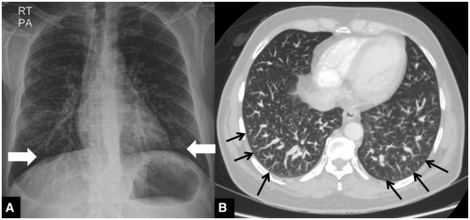Hepatopulmonary syndrome
| Hepatopulmonary syndrome | |
|---|---|
 | |
| a) Hepatopulmonary syndrome type 1 b) dilated distal pulmonary arteries | |
In medicine, hepatopulmonary syndrome is a syndrome of shortness of breath and hypoxemia (low oxygen levels in the blood of the arteries) caused by vasodilation (broadening of the blood vessels) in the lungs of patients with liver disease. Dyspnea and hypoxemia are worse in the upright position (which is called platypnea and orthodeoxia, respectively).
Signs and symptoms
The clinical presentation of this condition is as follows:[1]
- Shortness of breath (dyspnea)
- Red spots on skin
- Abnormal vascular dilatations
Pathophysiology
The hepatopulmonary syndrome results from the formation of microscopic intrapulmonary arteriovenous dilatations in patients with both chronic and far less common, acute liver failure. The mechanism is unknown but is thought to be due to increased liver production or decreased liver clearance of vasodilators, possibly involving nitric oxide.[2]
The dilation of these blood vessels causes overperfusion relative to ventilation, leading to ventilation-perfusion mismatch and hypoxemia. There is an increased gradient between the partial pressure of oxygen in the alveoli of the lung and adjacent arteries (alveolar-arterial [A-a] gradient) while breathing room air. Patients with HPS have platypnea-orthodeoxia syndrome (POS); that is, because intrapulmonary vascular dilations (IPVDs) predominate in the bases of the lungs, standing worsens hypoxemia (orthodeoxia)/dyspnea (platypnea) and the supine position improves oxygenation as blood is redistributed from the bases to the apices. [3]Additionally, late in cirrhosis, it is common to develop high output failure, which would lead to less time in capillaries per red blood cell, exacerbating the hypoxemia.
Diagnosis
The hepatopulmonary syndrome is suspected in any patient with known liver disease who reports dyspnea (particularly platypnea). Patients with clinically significant symptoms should undergo pulse oximetry. If the syndrome is advanced, arterial blood gasses should be measured on air.[citation needed] Hepatopulmonary syndrome (HPS) consists of the triad of liver dysfunction, otherwise unexplained hypoxemia, and intrapulmonary vascular dilation (IPVD). [3]
A useful diagnostic test is contrast echocardiography. Intravenous microbubbles (> 10 micrometers in diameter) from agitated normal saline that are normally obstructed by pulmonary capillaries (normally <8 to 15 micrometers) rapidly transit the lung and appear in the left atrium of the heart within 7 heart beats. Similarly, intravenous technetium (99mTc) albumin aggregated may transit the lungs and appear in the kidney and brain. Pulmonary angiography may reveal diffusely fine or blotchy vascular configuration. The distinction has to be made with an intracardiac right-to-left shunt.[citation needed]
Treatment
Currently the only definitive treatment is liver transplantation.[4] Alternative treatments such as supplemental oxygen or somatostatin to inhibit vasodilation remain anecdotal.[5]
Prognosis
With liver transplantation, the 5 year survival rate is 74%, which is comparable to patients who undergo liver transplants who do not suffer from hepatopulmonary syndrome.[6]
See also
References
- ↑ "Hepatopulmonary syndrome | Genetic and Rare Diseases Information Center (GARD) – an NCATS Program". rarediseases.info.nih.gov. Archived from the original on 21 March 2021. Retrieved 15 December 2021.
- ↑ Rodríguez-Roisin, MD, Roberto (May 2008). "Hepatopulmonary Syndrome — A Liver-Induced Lung Vascular Disorder". New England Journal of Medicine. 358 (22): 2378–87. doi:10.1056/NEJMra0707185. PMID 18509123.
- ↑ 3.0 3.1 Krowka MJ, et al. International Liver Transplant Society Practice Guidelines: Diagnosis and Management of Hepatopulmonary Syndrome and Portopulmonary Hypertension. Transplantation 2016; 100:1440.
- ↑ Rodriguez-Roisin, R; Krowka MJ (1994). "Is severe arterial hypoxaemia due to hepatic disease an indication for liver transplantation?". European Respiratory Journal. 7 (5): 839–842. PMID 8050537. Archived from the original on 7 June 2019. Retrieved 2 March 2011.
- ↑ Krowka MJ, Dickson ER, Cortese DA. Hepatopulmonary syndrome. Clinical observations and lack of therapeutic response to somatostatin analogue. Chest. 1993;104(2):515-21.
- ↑ Swanson, KL; Swanson KL; Wiesner RH; Krowka MJ. (12 April 2005). "Natural history of hepatopulmonary syndrome: impact of liver transplantation". Hepatology. 41 (5): 1122–1129. doi:10.1002/hep.20658. PMID 15828054.
Further reading
- Rodríguez-Roisin, Roberto; Krowka, Michael J. (29 May 2008). "Hepatopulmonary Syndrome — A Liver-Induced Lung Vascular Disorder" (PDF). New England Journal of Medicine. 358 (22): 2378–2387. doi:10.1056/NEJMra0707185. PMID 18509123. Archived (PDF) from the original on 3 March 2016. Retrieved 23 June 2019.